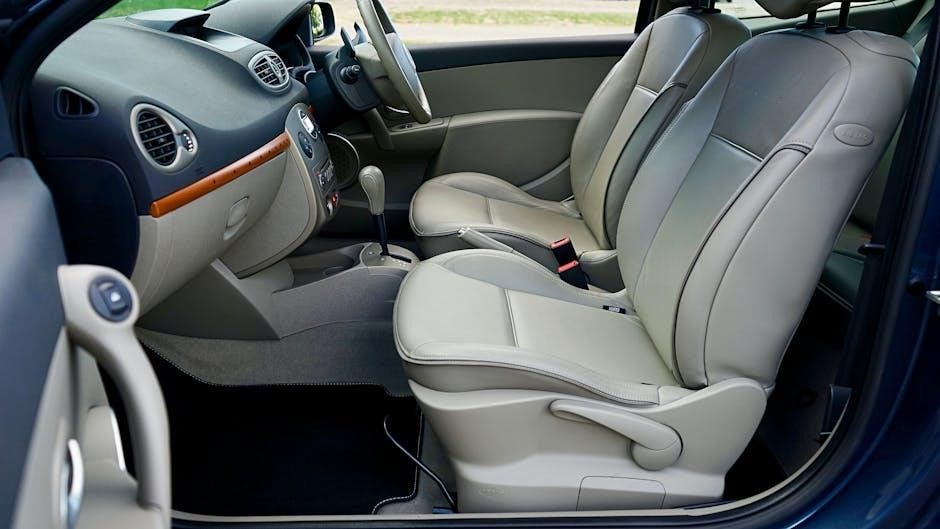A column manual shifter is a gear-shifting mechanism mounted on the steering column, commonly used in post-war vehicles. It operates manual transmissions, offering a compact and ergonomic solution for driver control.
1.1 Definition and Purpose
A column manual shifter is a gear-changing mechanism mounted directly on the steering column, designed to control manual transmissions. Its purpose is to provide drivers with a compact and ergonomic way to shift gears; Unlike floor-mounted shifters, column shifters save space inside the vehicle, making them ideal for smaller cars or those with specific interior designs. The shifter operates by connecting to the transmission via mechanical linkages, allowing precise gear selection. This design enhances driver convenience by keeping the shifting mechanism within easy reach, integrated into the steering column for a streamlined driving experience.

Historical Development of Column Manual Shifters
Column manual shifters emerged in the post-war era, gaining popularity in the 1940s and 1950s as a practical solution for controlling manual transmissions in vehicles.
2.1 Early Adoption in Post-War Vehicles
The column manual shifter gained widespread adoption in post-war vehicles, particularly in North America, during the 1940s and 1950s. This design was favored for its space efficiency and ergonomic benefits, allowing drivers to shift gears without reaching for a floor-mounted lever. The “three-on-the-tree” configuration, where three gears were controlled by a lever on the steering column, became a standard feature in many American cars. This setup was not only practical but also contributed to a cleaner interior design, making it a preferred choice for both automakers and consumers during this era.

Design and Components of Column Manual Shifters
Column manual shifters feature a steering column-mounted mechanism, shift forks, and linkages connecting to the transmission, with a shift knob for driver interaction.
3.1 Steering Column Mounted Shifter Mechanism
The steering column-mounted shifter mechanism integrates a lever attached to the steering column, connected via linkages to the transmission. This design allows gear selection without moving the driver’s hand far, enhancing convenience. The mechanism typically includes a shift knob, internal linkages, and shift forks that engage gears within the transmission. This system was widely used in post-war vehicles, offering a compact solution for manual transmissions. The column-mounted design optimizes space and maintains a clean dashboard, making it a practical choice for many classic and commercial vehicles.

Functionality of Column Manual Shifters
Column manual shifters enable precise gear selection via a lever on the steering column, allowing seamless manual transmission control while keeping hands near the steering wheel.
4.1 Operating Mechanics and Gear Selection Process
Column manual shifters function by linking the shifter lever on the steering column to the transmission via mechanical linkages. The driver engages gears by moving the lever through a gate, often requiring clutch pedal coordination. The process involves depressing the clutch, shifting into the desired gear, and releasing the clutch smoothly. This setup allows for straightforward gear changes while keeping the driver’s hands near the steering wheel, enhancing control and focus on driving. The mechanism relies on precise alignment and adjustment to ensure smooth, accurate gear engagement.
Types of Column Manual Shifters
Column manual shifters include three-speed and four-speed variants, commonly used in post-war vehicles. These shifters were integral to manual transmissions, offering drivers a straightforward gear-changing experience.
5.1 Three-Speed and Four-Speed Column Shifters
Three-speed and four-speed column shifters were prevalent in post-war vehicles, offering simplicity and efficiency. The three-speed shifter, known as the “three-on-the-tree,” was widely used in American cars, while the four-speed version provided additional gear ratios for better performance. Both designs utilized a lever mounted on the steering column, linked to the transmission via mechanical connections. These shifters were praised for their space-saving design and ease of use, making them a staple in many classic vehicles until the late 1960s when floor-mounted shifters gained popularity.

Advantages of Column Manual Shifters
Column manual shifters offer space efficiency and driver convenience, reducing cabin clutter and keeping controls within easy reach, enhancing the driving experience with ergonomic benefits.
6.1 Space Efficiency and Driver Convenience
Column manual shifters provide exceptional space efficiency by eliminating the need for a central console shifter, freeing up cabin space for other essential controls or storage. This design ensures a more organized and clutter-free interior, enhancing overall comfort. Additionally, the shifter’s placement on the steering column allows drivers to access gears without reaching, reducing distractions and keeping hands closer to the steering wheel. This ergonomic advantage minimizes driver effort, making it a practical solution for both everyday driving and specialized vehicles, where convenience and accessibility are paramount.

Challenges and Limitations
Column manual shifters face mechanical complexity, requiring precise linkage alignment and maintenance. Ergonomic issues can arise, as reaching for the shifter may cause discomfort during long drives.
7.1 Mechanical Complexity and Ergonomic Issues
Column manual shifters present challenges due to their intricate mechanical design, requiring precise alignment of linkages and constant maintenance to ensure smooth operation. The shifter’s position on the steering column can lead to ergonomic discomfort, as drivers must repeatedly reach and maneuver the lever, especially during frequent gear changes. This setup can be tiring on long drives or in heavy traffic, contributing to driver fatigue. Additionally, the compact placement may not suit all driving styles, further highlighting the need for careful design and adjustment to balance functionality and comfort.

Modern Applications of Column Manual Shifters
Column manual shifters are now used in commercial vehicles and specialty cars, offering space efficiency and ergonomic benefits. Modern designs integrate with advanced transmission systems for smoother operation.
8.1 Use in Commercial Vehicles and Specialty Cars
Column manual shifters are widely used in commercial vehicles, such as tractors and heavy-duty trucks, due to their space-saving design. In specialty cars, like vintage models or niche vehicles, they offer a nostalgic driving experience. Some modern commercial vehicles integrate column shifters with advanced features like engine brake modes and manual shifting options, enhancing driver control. Additionally, certain high-performance or custom cars adopt column-mounted shifters for ergonomic benefits and a classic aesthetic, appealing to enthusiasts who value both functionality and retro styling.

Installation and Maintenance
Installation involves aligning the steering column with the mounting bracket and securing it. Regular maintenance includes greasing moving parts and checking linkage connections for optimal performance.
9.1 Mounting and Adjustment Procedures
Mounting a column manual shifter involves aligning the steering column with the dashboard bracket and securing it with bolts. Adjustments ensure smooth gear shifting by fine-tuning the linkage connections. Loosen the adjustment nuts, position the shifter mechanism, and tighten the nuts to maintain precise alignment; Proper alignment prevents mechanical wear and ensures accurate gear engagement. Regular lubrication of moving parts and inspection of linkages are essential for long-term functionality. These procedures ensure the shifter operates seamlessly with the transmission system, providing reliable performance and driver convenience.
Cultural and Enthusiast Perspective
Column manual shifters evoke nostalgia among car enthusiasts, symbolizing a bygone era of driving simplicity. Their unique operation and retro appeal make them cherished in classic automotive culture.
10.1 Nostalgia and Popularity Among Car Enthusiasts
Column manual shifters hold a special place in automotive history, evoking nostalgia for classic cars. Many enthusiasts cherish the unique driving experience they offer, with their retro charm and simplicity. The “three-on-the-tree” configuration, common in post-war vehicles, became iconic in American automotive culture. Even though modern transmissions have advanced, the column shifter’s distinct operation and historical significance make it a beloved feature among collectors and retro car enthusiasts. Its enduring popularity highlights a deep appreciation for the simplicity and character of earlier automotive designs.

Future of Column Manual Shifters
Column manual shifters may integrate with modern transmission systems, offering space efficiency and driver convenience. Their nostalgic appeal could sustain them in niche or retro-inspired vehicles.
11.1 Integration with Modern Transmission Systems
Column manual shifters are being explored for integration with modern transmission systems, blending nostalgic design with advanced technology. Automated manual transmissions and ergonomic controls could benefit from this setup, maintaining the space-saving advantage while enhancing driver convenience. Future vehicles might combine column-mounted shifters with semi-automatic or dual-clutch systems, offering a unique driving experience. This integration could cater to both retro enthusiasts and modern drivers, ensuring the shifter remains relevant in evolving automotive landscapes.
Column manual shifters remain a significant part of automotive history, offering a unique blend of nostalgia and functionality. Their integration with modern systems ensures continued relevance in future vehicles.